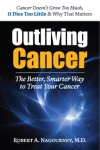The Angelina Jolie Effect
May 24, 2013 7 Comments
 Angelina Jolie’s willingness to bravely publish her saga, as she confronts the risk of a nefarious form of cancer, has focused international attention upon the phenomenon of genetic predisposition to cancer.
Angelina Jolie’s willingness to bravely publish her saga, as she confronts the risk of a nefarious form of cancer, has focused international attention upon the phenomenon of genetic predisposition to cancer.
The term BRCA, coined by investigators from Berkeley and Europe, described an inherited predisposition to cancer. Years of research came to fruition in the early 90s when geneticist Mary-Claire King and her collaborators recognized that patients who lacked DNA repair capacity tended to accumulate chromosomal damage that ultimately lead to cancer.
The BRCA genes (1 and 2) are part of the genomic fidelity system. Just like it sounds, these DNA repair enzymes maintain the “fidelity” or trueness of your makeup. Everyday our bodies are exposed to mutations. Radon in the atmosphere, carcinogens, even our dietary intake regularly injures our chromosomes. In response, we marshal defenses that recognize, remove and repair the damaged elements before they can be transmitted to the next generation of cells. When these BRCA genes are absent or silenced, the normal wear and tear goes unrepaired. Over a lifetime, this leads to a triggering mutation and cancer.
BRCA genes are like the Zamboni machines that clean up the ice in-between periods in a hockey game. Imagine what a Stanley cup game would be like if the ice was so dug up that the players took a tumble every time they skated toward the goal.
Ms. Jolie’s chromosomes are like the ice, but her Zamboni machine isn’t working.
So why would someone like Angelina Jolie get cancer? The reason why patients with the BRCA1 or 2 mutation get breast and ovarian cancer over other types of cancer remains somewhat of a mystery. But the reason that they get cancer at all is quiet clear. They accumulate damage they can’t repair.
That being the case, what happens when we introduce DNA damage intentionally? The answer is: patients with BRCA1 and BRCA2 respond to chemotherapy often quite dramatically. It is the very fact that cells cannot repair damage, which makes them hypersensitive to DNA damaging drugs like alkylators (cytoxan), platins (cisplatin and carboplatin) and ionizing radiation (x-rays). Indeed, tumors that carry DNA repair deficiencies are among the easiest to treat with conventional cytotoxics. Thus, the very reason that these patients develop cancers is the Achilles heel that makes their tumors drug sensitive.
Interestingly, BRCA1 and BRCA2 positive patients don’t only get breast and ovarian cancer; they can also develop melanoma, lymphoma and other tumors.
The importance of the BRCA discovery has been important on many levels. First and foremost it has enabled us to develop screening techniques to identify the at-risk populations that allows them to undertake preventative measures. Second, it has granted an insight into carcinogenesis and the concept of genomic fidelity. Third, it has provided new therapeutic options for these patients and all patients with cancers that have “BRCA-ness.”
Finally, it has opened up a field of investigation that connects cancer with other long-recognized disease states like the pediatric condition Fanconi’s anemia. It only reminds us again that cancer is but one part of a continuum of human diseases.



